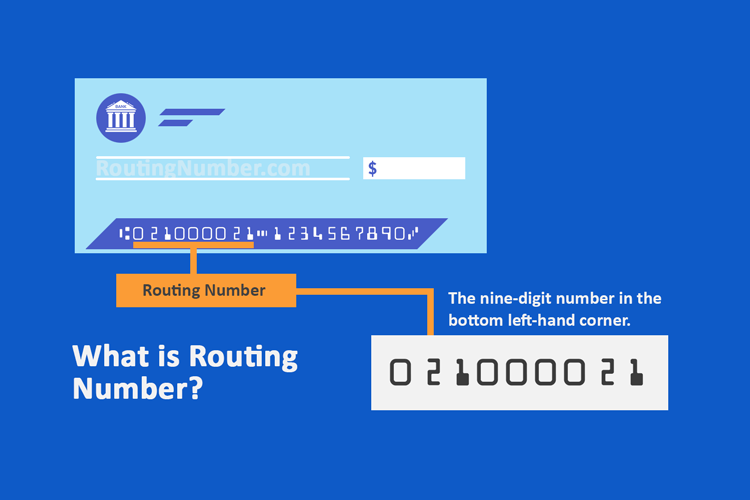Routing Number & Bank Account Lookup
Search routing number and bank account validation
Lookup example: 021000021 and account 26207729
What is Routing Number?
In the United States, a routing number (also called routing transit number) is a nine-digit code that identifies financial institutions. It is mainly used to facilitate the transfer of money between financial institutions through systems such as ACH, Fedwire, check etc. Routing number can be found on the bottom of a check.

Each financial institution can theoretically apply for up to 5 routing numbers according to policy. However, in reality, many institutions have more than 100 routing numbers due to mergers or acquisitions. The banks or credit unions that have multiple routing numbers may use different routing numbers for different purposes.
For example, some routing numbers are dedicated for use with Fedwire only, and cannot be used for ACH transfers. Some financial institutions may also assign routing numbers for specific regions or specific types of accounts, such as a business account. Difference betweeen USA and Canada bank routing number is length, payment schemes and management institutions. Canadian numbers are eighth-digit codes consist of FIN code - 3 digits long and the Transit Number - 5 digit long used in EFT payments and managed by Canadian Payments Association (CPA).
Therefore, it is very important to double check and use the correct routing number before making a money transfer. The Routing Number Lookup tool can help verify the Routing Number is associated with a specific financial institution. You can also find routing numbers on the websites of most financial institutions or by calling them directly.
Routing Number Format
The routing number can have two forms—fraction form and MICR (magnetic ink character recognition) form. Essentially, they contain the same information. MICR form is the more commonly used form, and it is very rare to see the fraction form as of 2020.
In MICR form, the routing number is in the form of
XXXXYYYYC
Where XXXX is Federal Reserve Routing Symbol, YYYY is the Financial Institution Identifier, and C is the Check Digit.
Within the 4 digit Federal Reserve Routing Symbol, the first two digits can only be 00 - 12, 21 - 32, 61 - 72, or 80. Within these ranges, 21 - 32 are assigned to thrift institutions only, such as credit unions and savings banks. 61 - 72 are special purpose numbers for non-bank payment processors and clearinghouses and are termed Electronic Transaction Identifiers (ETIs). 80 is for traveler's checks. Aside from 80, the first two digits can be associated with the 12 Federal Reserve Banks:
| Primary (01-12) | Thrift (+20) | Electronic (+60) | Federal Reserve Bank |
|---|---|---|---|
| 01 | 21 | 61 | Boston |
| 02 | 22 | 62 | New York |
| 03 | 23 | 63 | Philadelphia |
| 04 | 24 | 64 | Cleveland |
| 05 | 25 | 65 | Richmond |
| 06 | 26 | 66 | Atlanta |
| 07 | 27 | 67 | Chicago |
| 08 | 28 | 68 | St. Louis |
| 09 | 29 | 69 | Minneapolis |
| 10 | 30 | 70 | Kansas City |
| 11 | 31 | 71 | Dallas |
| 12 | 32 | 72 | San Francisco |
The check digit is the ninth digit of the routing number and must meet the following condition. This condition is mainly intended to reduce misrouting errors typically due to input errors.
3(d1+d4+d7) + 7(d2+d5+d8) + (d3+d6+d9) mod 10 = 0
For example, 111000038 is the routing number of the Federal Reserve Bank in Minneapolis.
3(1+0+0) + 7(1+0+3) + (1+0+8) = 40
40 mod 10 is 0, so the check digit condition was met.
Use the following checker to find out if a routing number is in the right MICR form.
List of largest banks in the United States
The following table provides a list of the major banks in the United States by assets of July 24, 2020.
| American Express | JPMorgan Chase |
| Bank of America | Key Bank |
| BBVA Compass Bank | Metabank |
| Capital One | PNC Bank |
| Citibank | Regions Bank |
| Citizens Bank | Suntrust Bank |
| Comerica Bank | TD Bank |
| Fifth Third Bank | Ally Financial |
| First National Bank | US Bank (U.S. Bancorp) |
| HSBC Bank | Wells Fargo Bank |